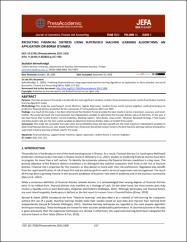Predicting financial distress using supervised machine learning algorithms : An application on Borsa Istanbul
Citation
Selimefendigil, S., (2023). Predicting financial distress using supervised machine learning algorithms: an application on Borsa Istanbul. Journal of Economics, Finance and Accounting (JEFA), 10(4), 217-223.Abstract
ABSTRACT
Purpose- The main purpose of this study is to identify the most significant variables to detect financial distress earlier and to find the best machine
learning algorithm model.
Methodology-This study has used Support Vector Machine, Logistic Regression, Random Forest and K-nearest neighbors method techniques to
predict the financial distress prediction for the companies of Turkey between 2012 and 2021.
Findings- As a result of the study, it has been determined that Random Forest provides the best results in terms of precision, accuracy, and recall.
Further, this study has found the most important five independent variables to determine the financial distress status of the firms. In this way, it
has been found that Current Assets/ Current Liabilities, Working Capital / Total Assets, Gross profit / Revenue, Retained Earnings / Total Assets
and Sales growth rate are the most useful variables to determine financial distress status of Turkish firms earlier.
Conclusion- This study has concluded that cash ratios and profitability ratios and sales growth are the most important independent variables to
determine financial distress one-year ahead. Furthermore, it has been found that random forest is the best machine learning method among other
supervised machine learning methods used in this study.

















